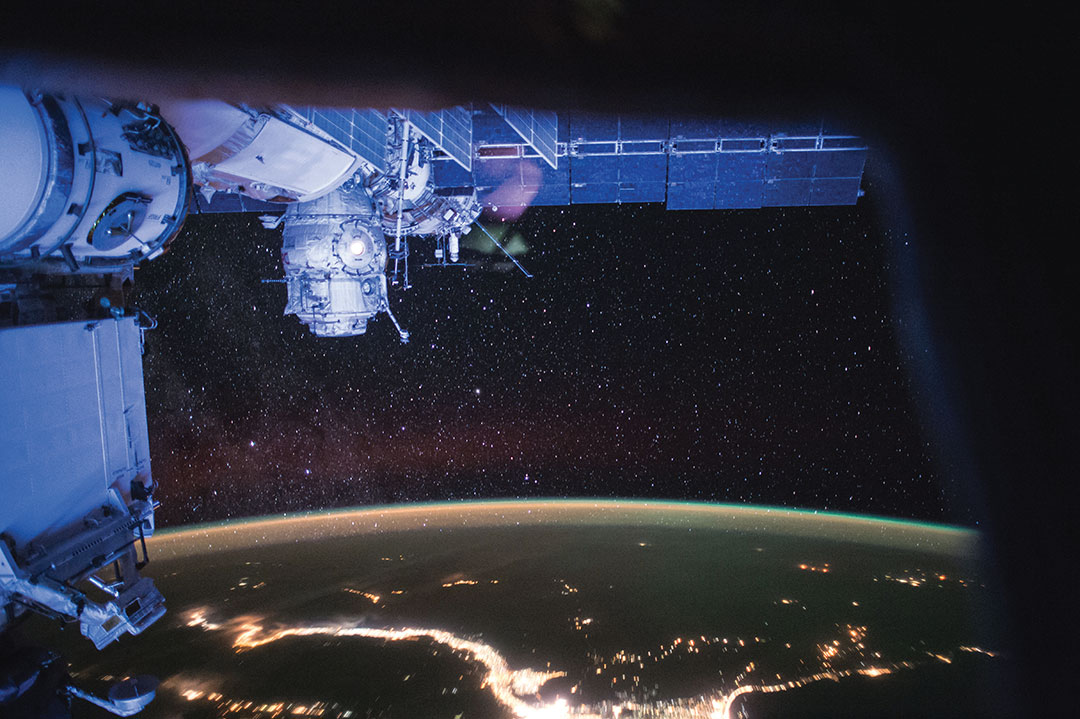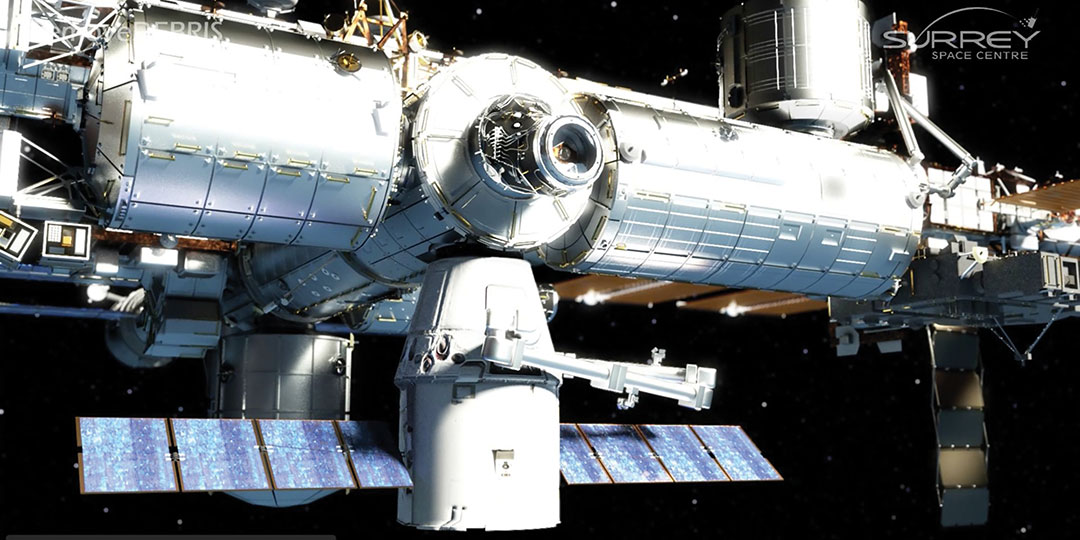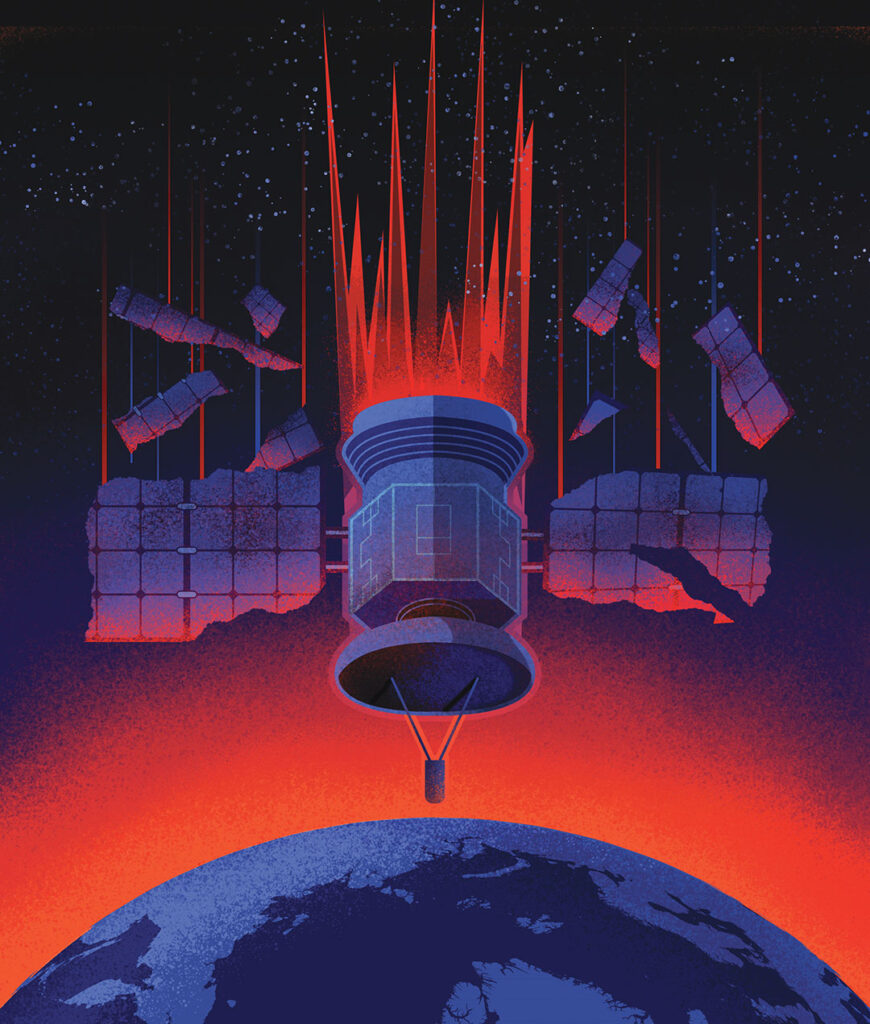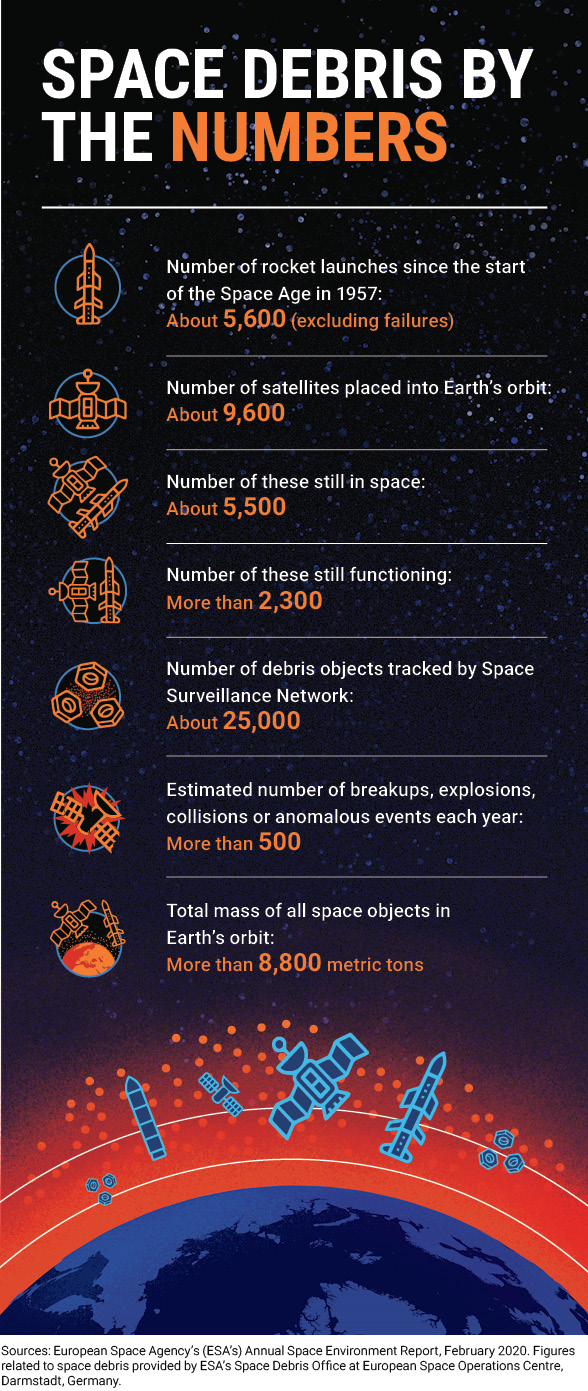Working together to defend the planet from orbiting debris
THE WATCH Staff
China tested its anti-satellite capabilities in 2007 by purposely destroying a nonfunctional weather satellite with a surface-launched, medium-range missile. The test created more than 3,300 pieces of debris larger than 10 centimeters in diameter. A collision with any one of these pieces would prove catastrophic to the average satellite circling Earth or even the International Space Station (ISS), according to the European Space Agency (ESA).
The missile test also produced more than 200,000 debris particles as small as 1 centimeter, large enough to disable a spacecraft or penetrate the ISS shields. Even a collision with a particle smaller than 1 millimeter, such as a fleck of paint, could destroy a satellite subsystem because even those particles travel at more than 24,700 kilometers per hour in orbit.
“Any of these debris have the potential for seriously disrupting or terminating the mission of operational spacecraft in low Earth orbit’’ about 400 to 2,000 kilometers up, explained Nicholas Johnson, chief scientist at the U.S. National Aeronautics and Space Administration’s (NASA’s) Orbital Debris Program, which was founded in 1979 at Johnson Space Center in Houston, Texas. “This satellite breakup represents the most prolific and serious fragmentation in the course of 50 years of space operations,” he told space.com after the 2007 test.

Two years later a defunct 950-kilogram Russian satellite known as Cosmos-2251 collided with and destroyed a functioning U.S. Iridium commercial satellite, creating another 2,000 large pieces and more than 100,000 smaller particles. Together, the two incidents increased the amount of debris in low Earth orbit by 60 %, with more than a third of the additional particles remaining in orbit for 20 more years.
In the past decade, the potential threat to satellites from orbital debris has continued to grow. The ESA estimates there are up to 34,000 pieces of space junk bigger than 10 centimeters in diameter; 900,000 objects between 1 to 10 centimeters; and 128 million objects between 1 millimeter and 1 centimeter in size orbiting the planet, for a combined mass of more than 8,800 metric tons — an amount greater than the mass of the metal structure of the Eiffel Tower. The figures include more than 2,500 satellites that are no longer operational but remain in orbit.
To mitigate the threat, the Space Surveillance Network (SSN), now led by U.S. Space Command (USSPACECOM), relies upon a global network of partners to identify, track and share information about space objects. Employing a range of internationally operated satellites, sensors, optical telescopes, radar systems and supercomputers, SSN actively tracks more than 25,000 man-made objects in orbit that are roughly the size of a softball or larger and then warns operators worldwide of pending collisions, according to Diana McKissock, a space lead with the U.S. Air Force’s 18th Space Control Squadron, which tracks space debris for SSN.
In 2017, for example, the U.S. Air Force documented 308,984 potential collisions with active satellites and issued 655 alerts to satellite operators, McKissock told The Watch. Operators reposition satellites roughly twice a week based on that information. Chief among the recent space hazards was China’s defunct Tiangong-1 space station that uncontrollably crashed to Earth on April 2, 2018, threatening land-based populations before its fiery demise. Luckily, the debris fell into the Pacific Ocean about 4,000 kilometers south of Hawaii.

Crowded Orbits
Managing man-made debris created by space missions is increasingly challenging, especially as space becomes more accessible and congested as ambitions grow. Today, 60 governments are operating more than 1,880 active satellites, and 12 countries and one governing body possess launch capabilities, according to the Union for Concerned Scientists, a nonprofit U.S.-based science association. Experts predict the number of satellites in orbit could more than triple over the next decade because an average of 300 satellites with a mass of more than 50 kilograms are now being launched each year, and the pace is expected to accelerate. Within two decades, the number of satellites circling the planet could increase by a factor of 10 to 16,000 and with it the number of alerts, according to a 2018 policy paper published by the Aerospace Corp.
Space-based systems confer technological, tactical and economic advantages on nations that possess those capabilities in the military and commercial sectors. Satellites enhance navigation, precision targeting, drone operations, communications, and real-time situational awareness on the battlefield and beyond. Some commercial companies such as SpaceX and OneWeb plan to launch thousands of small satellites.
The world’s increasing reliance on satellites reinforces the need for fostering cooperation and building partnerships, experts say. “As more space capabilities are launched worldwide and the number of people benefiting from the use of those systems grows, it is in all of our interests to work together to ensure the security, safety and sustainability of space,” U.S. Air Force Maj. Gen. Nina M. Armagno, director of plans and policy for U.S. Strategic Command (USSTRATCOM), said in April 2018, while the command was still charged with overseeing SSN. “The space domain is a global resource that is best protected and managed collectively.”
International Cooperation
Nations are already working together to improve monitoring capabilities as well as technologies to control space junk. To ensure safe operation in space, USSTRATCOM signed space situational awareness (SSA) agreements with 89 entities, including 14 countries and two intergovernmental agencies to share data. USSPACECOM began assuming management of the agreements soon after the command was stood up in August 2019. The entities include Australia, Belgium, Canada, Denmark, France, Germany, Israel, Italy, Japan, Norway, South Korea, Spain, the United Arab Emirates and the United Kingdom, as well as the European Space Agency and the European Organization for the Exploitation of Meteorological Satellites. USSTRATCOM has been monitoring space junk since 1957 when the Soviets launched Sputnik I. USSPACECOM now also shares information with more than 65 commercial satellite companies and is working to expand the network. “Anyone in the world can request our data,” McKissock told The Watch.
The SSA Sharing Program offers collision warning information for the lifetime of a satellite. The Joint Space Operations Center can provide prelaunch information to foreign and commercial operators to prevent collision of space objects with the launch vehicle and payload into early orbit. The program also conducts satellite reentry assessments and can help track asteroid threats, as it did when the 45-meter-wide Asteroid 2012 DA14 passed between Earth and its geostationary satellites in February 2013.
The SSN includes a Space Based Space Surveillance satellite, which orbits at 628 kilometers above the planet, and sensors operated by Australia, Canada, Norway and the United Kingdom, as well as the Space Surveillance Telescope (SST), developed by the U.S. Defense Advanced Research Projects Agency. The SST, which can detect faint objects in geosynchronous orbit up to 35,400 kilometers high, is being moved to Australia from New Mexico to enhance launch detection and tracking in the Southern Hemisphere. In addition, the U.S. upgraded a C-band radar and recently moved it from Antigua Air Station in the Caribbean to Naval Communication Station Harold E. Holt in Exmouth, Western Australia. The radar became operational in 2017.
The SSN also includes the Space Fence System radar, a second-generation space surveillance system designed to track artificial satellites and space debris in low Earth orbit, which is nearing completion. The initial large S-band radar and facilities were built at Kwajalein Atoll in the Marshall Islands and were declared operational in March 2020. There is an option for another radar site in Western Australia. The enhanced capabilities will enable faster warnings of potential space debris collisions and a greater number — perhaps as many as 200,000 objects, including those down to 4 centimeters in diameter — to be tracked and cataloged.
The international space community also formed the Inter-Agency Space Debris Coordination Committee (IADC) in 1993 to serve as an international governmental forum for the worldwide coordination of activities related to the issues of human-made and natural debris in space. IADC’s members include experts on space debris and other specialists from 13 space agencies, including the Canadian Space Agency, China National Space Administration, European Space Agency, Indian Space Agency, Japan Aerospace Exploration Agency, Korea Aerospace Research Institute and NASA. USSPACECOM also supports IADC’s efforts and those organized by the United Nations Office for Outer Space and its Committee for the Peaceful Uses of Outer Space to address space debris.
Nations are stepping up their contributions to space junk management. Japan added a space monitoring division in 2019 within its Self-Defense Force. “Initially, the force will be tasked with monitoring dangerous debris floating in Earth’s orbit and with protecting satellites from collisions with space debris,” according to The Japan Times newspaper. Japan will share information obtained by the new division with the U.S. military to strengthen cooperation in space, the newspaper said.
Managing the Threat
Nations are teaming up to develop ways to remove space debris from orbit, testing many of the systems from the International Space Station (ISS). A consortium of researchers, led by Guglielmo Aglietti, director of the Surrey Space Centre at the University of Surrey, has been developing methods that strive to tether, harpoon or net space junk and bring such debris down to about 200 kilometers above the surface to reenter Earth’s atmosphere and be burned up. The RemoveDebris satellite carrying the leading wave of these experiments was deployed from the ISS in June 2018 by the Japanese experiment module’s robotic arm to begin a series of tests.
“We have spent many years developing innovative active debris removal systems to be at the forefront of tackling this growing problem of space debris,” said Nicolas Charmussy, head of Airbus Space Systems, which developed three of the key technologies aboard the RemoveDebris satellite. “We will continue to work close with teams across the world to make our expertise available to help solve this issue.”
Space scientists from various space-faring nations are also working on approaches to create high-powered lasers that can vaporize space junk of all sizes. In 2015, Japanese researchers first proposed focusing small lasers into a beam and mounting them on Japan’s module on the ISS or on a satellite to target debris. Researchers at China’s Air Force Engineering University in Xi’an, Shaanxi province, proposed using satellite-mounted lasers to blast orbital debris, including pieces less than 10 centimeters wide. They published their approach in a February 2018 article in Optik, the international journal for light and electron optics.
Meanwhile, Precision Instrument Systems, which is a research and development branch of the Russian space agency, plans to build a 3-meter optical telescope that can track space junk in orbit and then blast it into oblivion, the Live Science website reported in June 2018.
Mitigating Future Risk
In the future, as space becomes more crowded, space junk could become even more perilous due to the Kessler effect. The notion posited in 1978 holds that as the density of objects in space increases, so does the probability for collisions between them. In a Kessler syndrome event in a congested orbit, one collision leads to another and another, creating a disastrous chain reaction of collisions of space junk that could close regions of Earth’s orbit to satellite traffic altogether.
Most space scientists think this wouldn’t happen, if it happens at all, for several decades, however. “I’m not saying we couldn’t get there, and I’m not saying we don’t need to be smart and manage the problem,” Jesse Gossner, an orbital-mechanics engineer who teaches at the U.S. Air Force’s Advanced Space Operations School, told the website Business Insider. “But I don’t see it ever becoming, anytime soon, an unmanageable problem.”
Gossner, McKissock and many other experts think finding, tracking and alerting parties about potential collisions remains the most effective approach to managing debris. “It’s just a matter of watching and, with our active satellites that we do control, avoiding collisions,” Gossner said. “It becomes a very important problem not just for that satellite, but then for the debris that it would create.” And for now, some space scientists contend, the smallest particles, which are not trackable, may do the most damage.
Space debris of all varieties will undoubtedly be a continuing challenge for the international community as space ambitions and dependence grow. “Space is going to be a vulnerable domain, so we’re going to have to think of ways to mitigate that risk and mitigate those threats,” Elbridge Colby, then a senior fellow at the Center for a New American Security and later Deputy Assistant Secretary of Defense for Strategy and Force Development, told The Washington Post newspaper in January 2016.
USSPACECOM will be up to the challenges. U.S. President Donald J. Trump first revealed his plans to revive the command in June 2018. Shortly thereafter, Gen. John Hyten, now vice chairman of the Joint Chiefs of Staff, pledged the space situational awareness mission within the Department of Defense would continue for reasons of national security. “That will not change … because we have to have that information in order to defend ourselves against potential threats,” he said in his June 22, 2018, testimony to the House Armed Services Committee, when he was still head of USSTRATCOM.
The cost of not doing so could be immense. “Every day, we use and rely on services provided by satellites without ever realizing how vulnerable they are,” Dr. Hugh Lewis, head of astronautics research at the University of Southampton, told Wired UK in April 2017. “It’s not just that satellites can be damaged or destroyed by space debris today or tomorrow, it’s that the actions of our generation may affect the dreams and ambitions of future generations to work and live in space.”


